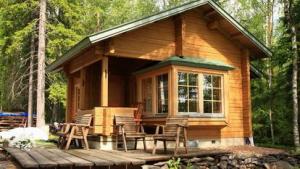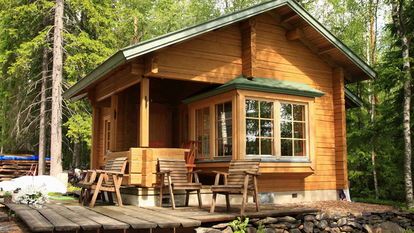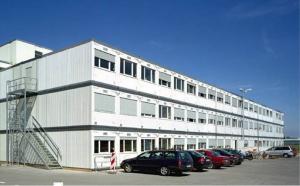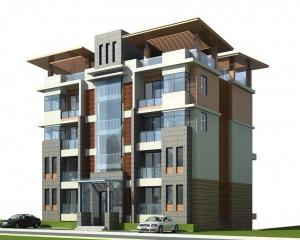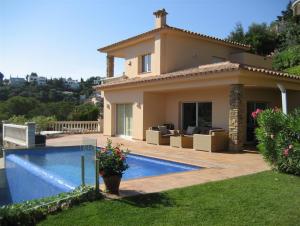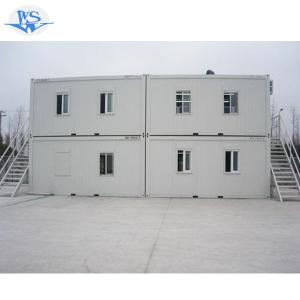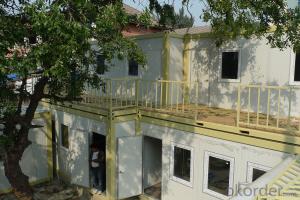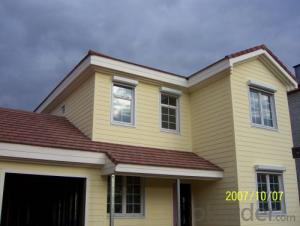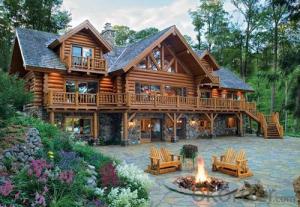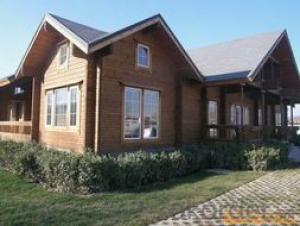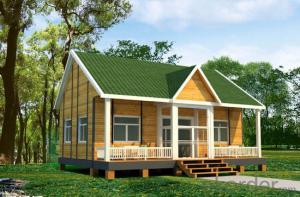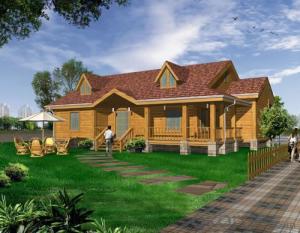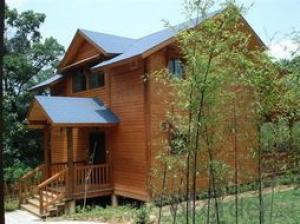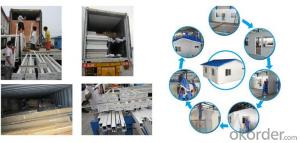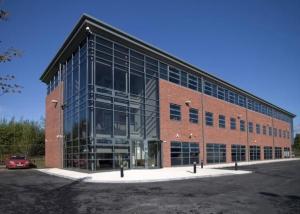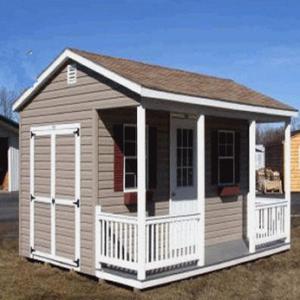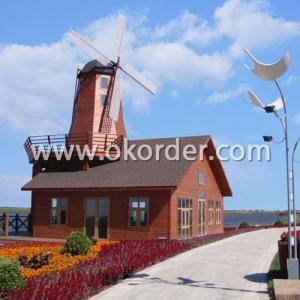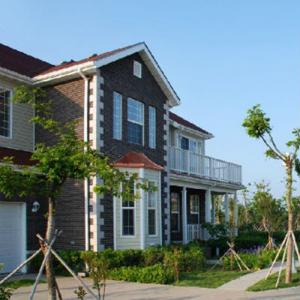Wooden house, log houses
- Loading Port:
- China Main Port
- Payment Terms:
- TT OR LC
- Min Order Qty:
- -
- Supply Capability:
- -
OKorder Service Pledge
Quality Product, Order Online Tracking, Timely Delivery
OKorder Financial Service
Credit Rating, Credit Services, Credit Purchasing
You Might Also Like
wooden villa house; Wooden house, log houses
Simple and founctional family living house
Specifications
Wooden house, garden hose, children's play house
- Q: Can container houses be designed with a built-in security system?
- Yes, container houses can definitely be designed with a built-in security system. In fact, many container house manufacturers and designers are aware of the importance of security measures and offer various options to enhance the safety and security of these homes. One common approach is to incorporate surveillance cameras as part of the security system. These cameras can be strategically placed around the house to monitor the surroundings and deter potential intruders. Additionally, motion sensors can be installed to detect any movement around the property and trigger an alarm if necessary. Another important aspect of security is the entry points of the container house. Manufacturers can equip the doors and windows with robust locks and reinforced materials to make them more secure. Some designs even include smart locks that can be controlled remotely via a smartphone, allowing homeowners to lock and unlock their doors from anywhere. Furthermore, container houses can be integrated with security systems that include features like alarm systems, smoke detectors, and even home automation capabilities. These systems can be connected to a central control panel, which allows homeowners to easily monitor and control all aspects of their security system. It is important to note that while container houses can be designed with a built-in security system, the level of security ultimately depends on the specific features and technologies implemented. Homeowners should carefully consider their security needs and consult with professionals to ensure that the chosen security system meets their requirements.
- Q: Can container houses be designed with a traditional or historical theme?
- Yes, container houses can definitely be designed with a traditional or historical theme. While shipping container homes are often associated with modern, minimalist designs, there is no limitation on the style or theme that can be applied to these structures. With the right design elements, materials, and finishes, container houses can be transformed to reflect traditional or historical aesthetics. To achieve a traditional or historical theme, various architectural elements can be incorporated into the design. For example, the exterior of the container house can be clad with traditional materials such as brick, stone, or timber, giving it a timeless look. Historical architectural features like gables, dormer windows, or ornamental details can be added to enhance the overall design. The interior of the container house can also be designed with a traditional theme by using appropriate materials, colors, and furnishings. For instance, reclaimed wood or antique furniture can be used to create a rustic or vintage atmosphere. Traditional moldings, wainscoting, or decorative wallpapers can be added to the walls to evoke a sense of history. Furthermore, landscaping and outdoor design can contribute to the traditional or historical theme of a container house. Traditional garden elements like well-manicured lawns, flower beds, or hedges can be incorporated to create a charming and nostalgic ambiance. In conclusion, container houses can absolutely be designed with a traditional or historical theme. With careful consideration and creative design choices, these structures can seamlessly blend into their surroundings and reflect the desired aesthetic.
- Q: Are container houses suitable for educational or training centers?
- Yes, container houses can be suitable for educational or training centers. Container houses have gained popularity as an alternative and sustainable building solution due to their affordability, versatility, and ease of construction. These factors make them well-suited for educational or training centers, where limited budgets and quick construction timelines are often a concern. Container houses can be easily customized to meet the specific needs of an educational or training center. They can be designed to include classrooms, offices, meeting rooms, laboratories, and other necessary facilities. The modular nature of containers also allows for easy expansion or reconfiguration as the needs of the center evolve over time. Furthermore, container houses can be equipped with necessary amenities such as heating, cooling, electricity, and plumbing, ensuring a comfortable and functional learning environment. They can also be fitted with insulation to provide a suitable environment for all seasons. Additionally, container houses are environmentally friendly as they make use of recycled shipping containers, contributing to the reduction of carbon footprint. This can align with the educational or training center's sustainability goals and serve as a practical example for students or trainees. In conclusion, container houses are a viable and suitable option for educational or training centers. They offer cost-effective, customizable, and sustainable solutions, making them an attractive choice for institutions looking to establish or expand their facilities.
- Q: Are container houses customizable in terms of size?
- Yes, container houses are customizable in terms of size. The modular nature of shipping containers allows for easy modification and customization to fit specific requirements. Container houses can be expanded or reduced in size by adding or removing containers, and can also be stacked or joined together to create larger living spaces. This flexibility in sizing makes container houses a popular choice for those looking for a custom-built and unique living space.
- Q: Can container houses be designed with a green roof?
- Yes, container houses can definitely be designed with green roofs. Green roofs, also known as living roofs or vegetated roofs, are roofs that are covered with vegetation, plants, and sometimes even small trees. They provide numerous environmental benefits such as reducing stormwater runoff, improving air quality, and providing insulation for the building. Container houses, which are built using shipping containers, can easily be designed with green roofs. The structure of the containers provides a solid base for the green roof to be installed. The containers can be modified to create a flat roof surface, which is ideal for green roof installations. To design a container house with a green roof, certain considerations need to be taken into account. The weight of the green roof and the additional load it will put on the container structure must be carefully calculated to ensure it can safely support the roof. Adequate waterproofing and drainage systems must also be implemented to prevent leaks and ensure proper water management. In addition to the environmental benefits, green roofs on container houses can also enhance the aesthetic appeal of the building. They can create a beautiful, natural look and blend the house with its surroundings. Green roofs can also provide additional outdoor space for residents to enjoy, such as rooftop gardens or relaxation areas. Overall, container houses can indeed be designed with green roofs, providing an eco-friendly and visually appealing option for sustainable housing.
- Q: Are container houses suitable for artist residencies or creative spaces?
- Due to their distinctive features and advantages, container houses are an ideal choice for artist residencies or creative spaces. Firstly, they provide a cost-effective solution for artists and organizations with limited budgets. As these structures are constructed from repurposed shipping containers, they often come at a fraction of the cost of traditional building materials. This affordability allows artists to allocate more resources towards their creative endeavors. Secondly, container houses are incredibly versatile and customizable. Artists can easily modify the layout and design of these structures to suit their specific needs and preferences. Whether it involves adding windows to bring in natural light, creating open spaces for exhibitions or workshops, or dividing the space into separate studios, container houses can be adapted to accommodate various artistic practices. Furthermore, container houses are environmentally friendly and sustainable. By repurposing shipping containers, artists contribute to waste reduction and promote a more sustainable way of living. This aligns with the values of many artists who prioritize environmental consciousness in their work. Container houses also possess a unique aesthetic appeal that can enhance the creative atmosphere of an artist residency or creative space. The industrial look and feel of these structures can inspire and stimulate creativity, setting the tone for a one-of-a-kind artistic experience. Moreover, container houses are easily transportable and relocatable. This portability allows artists to establish residencies or creative spaces in different locations, providing them with new surroundings and inspirations. It also facilitates collaborations between artists from different regions, fostering a diverse and vibrant creative community. However, it is essential to consider the limitations of container houses when contemplating them for artist residencies or creative spaces. These structures may have restricted interior space, which can pose challenges for those requiring larger workspaces or specific equipment. Additionally, insulation and climate control may be necessary to ensure comfortable living and working conditions throughout the year. In conclusion, container houses are highly suitable for artist residencies or creative spaces. Their affordability, versatility, sustainability, and unique aesthetic appeal make them an attractive option for artists and organizations seeking innovative and cost-effective solutions to support their artistic practices.
- Q: Are container houses suitable for areas with limited access to utilities?
- Yes, container houses are suitable for areas with limited access to utilities. Container houses are designed to be highly adaptable and can be equipped with various off-grid systems such as solar panels, rainwater harvesting, composting toilets, and propane tanks for cooking and heating. These off-grid solutions make container houses a viable option for areas with limited access to utilities, as they provide self-sufficiency and reduce reliance on traditional infrastructure.
- Q: Are container houses suitable for mountainous regions?
- Yes, container houses are suitable for mountainous regions. The structural integrity and durability of shipping containers make them an excellent choice for areas with rugged terrain and harsh weather conditions. Container houses can withstand heavy snow loads, high winds, and even earthquakes, making them a reliable housing option in mountainous regions where traditional construction materials may not be as robust. Furthermore, container houses can be easily transported and installed in remote areas, which is often the case in mountainous regions. The modular nature of shipping containers allows for easy assembly and disassembly, making them ideal for locations with limited accessibility. Additionally, the compact size of containers makes them suitable for small plots of land, which are often found in mountainous areas. Moreover, container houses can be designed to be energy-efficient and environmentally friendly. They can be equipped with insulation, solar panels, and other sustainable features, ensuring that they are well-suited for the challenging climate conditions of mountainous regions. This not only provides a comfortable living environment for residents but also reduces their ecological footprint. In conclusion, container houses are indeed suitable for mountainous regions. Their durability, mobility, and adaptability make them an excellent housing solution that can withstand the unique challenges of living in rugged terrains.
- Q: Are container houses suitable for remote work or telecommuting?
- Yes, container houses can be suitable for remote work or telecommuting. These houses are designed to be portable and customizable, making them adaptable to different environments. With the right amenities and technology, container houses can provide a comfortable and functional workspace for remote workers. Additionally, their affordability and sustainability make them an attractive option for individuals seeking a remote work setup in remote or off-grid locations.
- Q: Are container houses resistant to floods or water damage?
- Floods or water damage can be resisted by container houses if they are designed accordingly. Waterproofing and flood resistance can be achieved through the use of appropriate construction techniques and materials. The primary concern is to ensure the proper sealing of the containers and the implementation of effective water drainage systems. Furthermore, elevating the containers on a raised foundation or incorporating flood-resistant designs can provide an additional level of protection against flooding. It should be emphasized that the specific location and severity of the flood must also be taken into account when considering the flood resistance of container houses.
Send your message to us
Wooden house, log houses
- Loading Port:
- China Main Port
- Payment Terms:
- TT OR LC
- Min Order Qty:
- -
- Supply Capability:
- -
OKorder Service Pledge
Quality Product, Order Online Tracking, Timely Delivery
OKorder Financial Service
Credit Rating, Credit Services, Credit Purchasing
Similar products
Hot products
Hot Searches
Related keywords
